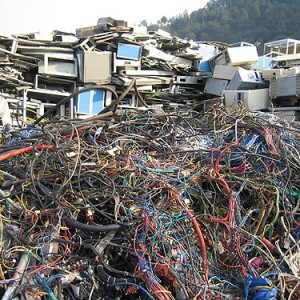 140 thousand tons of e-waste ends up in our landfills each year. E-Waste also contains toxic chemicals such as: lead, mercury and arsenic which threaten our water and air supply. The Story of Electronics attributes e-waste to planned obsolescence, lack of regulations and corporate greed. Much of this waste is illegally exported to developing countries where workers are exposed to these toxic chemicals on a daily basis. Here in Canada, only about 25% of this waste is actually recycled. There seems to be many barriers to the amount of e-waste in our landfills such as: lack of awareness, geographic accessibility to recycling depots and costs to dispose. While some provinces require manufacturers to develop/comply with product stewardship plans, these legislations are loosely monitored and are not federally applicable.
140 thousand tons of e-waste ends up in our landfills each year. E-Waste also contains toxic chemicals such as: lead, mercury and arsenic which threaten our water and air supply. The Story of Electronics attributes e-waste to planned obsolescence, lack of regulations and corporate greed. Much of this waste is illegally exported to developing countries where workers are exposed to these toxic chemicals on a daily basis. Here in Canada, only about 25% of this waste is actually recycled. There seems to be many barriers to the amount of e-waste in our landfills such as: lack of awareness, geographic accessibility to recycling depots and costs to dispose. While some provinces require manufacturers to develop/comply with product stewardship plans, these legislations are loosely monitored and are not federally applicable.
Traditionally, manufacturers found the handling of e-waste to be uneconomical. Disposal costs were essentially passed down to the government and consumers. Recently, Samsung has taken upon itself to recycle e-waste through its Samsung Recycling Direct program. In partnership with recycling company Global Electric Electronic Processing (GEEP), consumers will not have to pay a fee when they drop off their Samsung-branded electronics at the 40 depots across Canada. Other branded electronics cost a nominal fee to recycle according to their website. Some Purolator locations will also accept electronics for drop-off and they will be transported to GEEP depots.
Below is a video explaining Samsung’s Recycling Direct program:
I like that Samsung is taking the whole life-cycle into consideration and trying to remove common barriers to recycling e-waste such as cost and geographic accessibility. There’s probably an incentive for Samsung to recycle these electronics (other than the perceived altruism) perhaps in the form of reusing parts. Supporters of manufacturers taking back these electronics suggest than the increased cost in disposal will counter planned obsolescence and financially encourage manufacturers to make more recyclable and longer lasting products. It will be interesting to see how this e-waste recycling program will affect the life-cycles of Samsung products and whether other large manufacturers will join them in this area.
-JN
